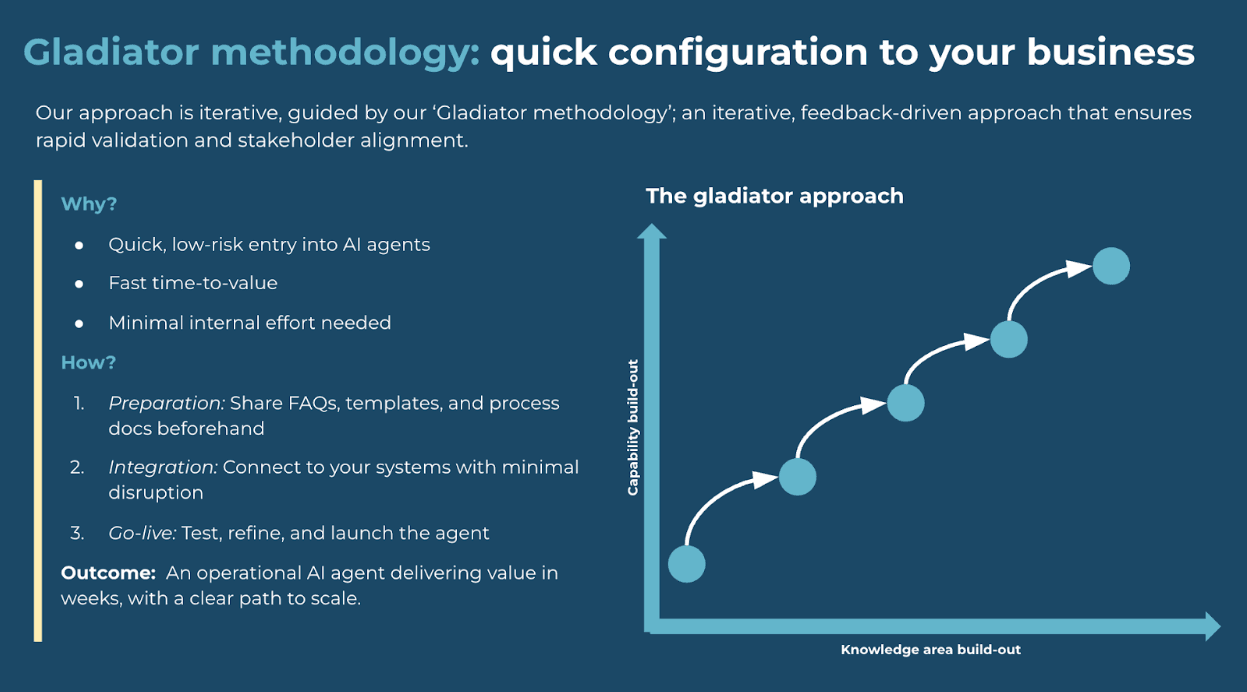
How our “Gladiator methodology” delivers AI value in a couple of weeks
Most enterprises fail at AI due to process, not tech. This article introduces the "Gladiator methodology," a fast, participatory approach that moves organizations from concept to operational AI agents in weeks, building trust and momentum.
How our “Gladiator methodology” delivers AI value in a couple of weeks
Most enterprises don’t fail at AI because of technology. They fail because of process. Endless pilots, internal debates, and PowerPoint proof-of-concepts stall momentum long before real value lands. The Gladiator methodology flips that dynamic. Built for speed, trust, and engagement, it moves organizations from concept to operational AI agents in just a couple of weeks, with minimal disruption and maximum energy.
This matters now because AI is shifting from experimental labs to live enterprise operations. Companies no longer need more theory, they need working systems that deliver results fast. Our Gladiator approach turns AI deployment into an arena sport, public, participatory, and surprisingly fun. It sparks collaboration across business domains and surfaces the real question: how should things actually work around here? When teams co-create with digital colleagues, the transformation stops being abstract and starts being cultural.

“ This approach was not born in a boardroom. It started with our collaboration with Byggmax, a team that wants real AI outcomes, not slide decks. We built fast, tested live, and discovered that the magic wasn’t just in the tech, but in the collaboration. Since then, we’ve refined the method with clients across industries, and the pattern is the same every time: once people see AI in action, trust replaces hesitation, and the whole organisation starts rethinking how work actually gets done. ”
From pilot paralysis to practical AI
Traditional enterprise AI programs overpromise and underdeliver. Months go by before anything works, and by then, stakeholder interest has evaporated. The Gladiator approach changes the tempo, delivering something real within weeks, not quarters.
- Fast, low-risk entry point for AI agents
- Tangible value in a couple of weeks
- Real-time collaboration across functions
- Continuous stakeholder feedback
Because the process is open, it naturally builds trust. People see what the AI can and cannot do. The transparency turns hesitation into learning;instead of fearing automation, teams start understanding its limits and potential. It’s not a black box, it’s a colleague in training.

“ Gladiator gave us momentum. Within weeks we moved from discussions to a working AI colleague that teams could interact with. Seeing the agent evolve live built both trust and understanding of what the technology can actually do, it turned AI from a concept into something we work with every day. ”
The “arena” approach to building AI
Algorithma’s Gladiator methodology is equal parts design discipline and delivery framework. It’s structured around a tight feedback loop, rapid validation, live testing, and fast iteration.
Three stages of deployment:
- Preparation: Gather FAQs, templates, and process docs to define scope clearly.
- Integration: Connect the AI agent to systems with minimal disruption.
- Go-live: Test, refine, and launch the agent, then expand step by step.
Each phase is fueled by Gladiator sessions, weekly, interactive reviews where colleagues from across business domains collaborate and critique:
- Walkthroughs of the agent’s latest outputs
- Direct input from real users
- Instant refinements based on live reactions
One of our clients said: “It became a team sport. Everyone had an opinion, and that made the AI better, fast. Even though we in the team didn’t always agree”
By the end of the second week, most of our clients have a prototype working AI colleague that’s not only performing tasks but also sparking the right discussions about how the organization actually works.


“ From a delivery standpoint, Gladiator changed the rhythm of how clients work with AI. It’s structured, but not rigid. It creates momentum and trust in a way traditional projects rarely do. When teams from IT, business, and operations sit together watching an AI agent evolve live, something clicks, they stop talking about AI as a future capability and start treating it as a colleague that’s already here. ”
Building trust through transparency
Gladiator isn’t just about delivery speed, it’s about organizational learning. Every iteration exposes where AI shines, and where human expertise still leads. That honesty builds confidence.
- Transparent validation of AI limits and strengths
- Shared ownership of the AI’s evolution
- Teams learn together through doing, not theorizing
- Trust built through clarity, not hype
Another one of our clients: “Seeing where it struggled helped us trust it more. We finally understood what ‘AI-ready’ means for us.”
This process doesn’t just create AI capability, it builds internal capability. When colleagues across marketing, finance, and operations shape an agent together, they learn to speak a shared language of value, data, and improvement. The AI becomes a mirror for how collaboration could, and should, work.
Why Gladiator isn’t just Agile with AI sprinkled on top
It’s tempting to compare the Gladiator methodology to Agile or Scrum, short cycles, live feedback, iterative delivery. But the similarity ends there. Agile was designed for software sprints, not organizational learning. Gladiator is built for transformation in public, where business teams, not developers, are in the arena shaping how AI agents actually work.
Agile hides behind backlogs and velocity charts. Gladiator is out in the open. It’s messy, visible, and deliberately so. Every iteration exposes gaps in data, process, and ownership. That transparency isn’t a bug, it’s the point, it forces alignment on how things should really work, not just how they’re currently coded.
- Agile optimizes output , Gladiator optimizes understanding.
- Agile relies on pre-scoped user stories, Gladiator rewrites the story as it unfolds.
- Agile ships features, Gladiator builds trust and capability.
In short, Agile delivers faster projects. Gladiator delivers smarter organizations. One participant said: “We realized it wasn’t about sprinting faster, it was about learning together.”
What enterprises should do now
If your AI roadmap is stuck in PowerPoint, the way forward isn’t another steering group, it’s an arena. Start small, move fast, and make it visible. The Gladiator methodology shows how to operationalize AI value in weeks while building trust and teamwork along the way.
Three practical steps:
- Identify one high-impact process that would benefit from transparency and automation.
- Commit to a couple of weeks of fast, fun iteration with cross-domain teams.
- Dare to go into production, move our digital colleague out of the arena into the real world
Algorithma’s framework, from AI inception to AI agent management, turns AI into a living, learning part of the business. In the age of agentic AI, the winners are those who combine speed, trust, and curiosity, and who dare to step into, and eventually out of, the arena together.